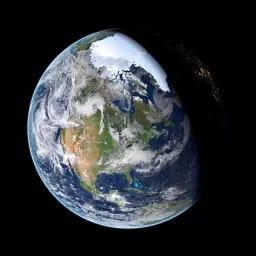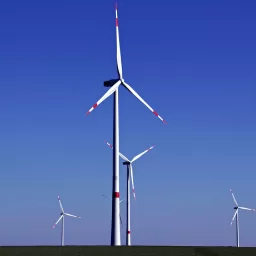Introduction:
Global Warming, aside from pollution is one of the biggest scientist’s concerns. Global Warming is the term used to describe increase in the temperature of the Earth. It is the process which is continuously warming the earth. The Earth’s surface temperature has risen by about one degree Fahrenheit in the past century, with accelerated warming during the past three decades. There is stronger evidence and proof that most of the warming over the last fifty years is attributable to activities of human. Human activities have changed the chemical composition of the atmosphere and environment through the buildup of greenhouse gases, which are main cause of Global Warming.
There are four steps in the Greenhouse effect, which are, Ultraviolet rays from the sun, through space, to earth’s atmosphere. The sunlight enters the atmosphere and hits Earth. Some of sunlight turns into heat energy in the form of infrared light. The heat gets impregnated by enclosing air and land, which in turn makes it hot. Infrared rays that are remitted into the atmosphere are captured by greenhouse gases. The gas then absorbs the light and is sent back to the surface of Earth and warms it even more.
“According to the National Academy of Sciences, the Earth’s surface temperature has risen by about 1 degree Fahrenheit in the past century, with accelerated warming during the past two decades. There is new and stronger evidence that most of the warming over the last 50 years is attributable to human activities. Human activities have altered the chemical composition of the atmosphere through the buildup of greenhouse gases – primarily carbon dioxide, methane, and nitrous oxide. The heat-trapping property of these gases is undisputed although uncertainties exist about exactly how earth’s climate responds to them.”
Methane and carbon dioxide are some of the naturally occurring greenhouse gases. This is the manner in which the Earth keeps itself temperate enough for humans to live on it. The only concern with this is that humans are enhancing the process even further and it will result in Global Warming.
Over the past many years the emissions of greenhouse gases have been multiplying due to the rapid growth in technology that humans have perfected like, factories which are emitting such dangerous gases which includes methane, carbon dioxide, nitrous oxide, and ozone depleting substances such as CFCs, also known as Hydro-fluorocarbons, Chlorofluorocarbons, and Per-fluorocarbons.
Basically global warming is the ascent of the earth’s surface temperature due to chemicals in the atmosphere. The threats that global warming brings along with it includes: affecting the climate of the Earth and even the health of the people. This also includes altering of crop seasons. Global warming also affects the way organisms survive on the planet.
Signs and Effects:
A large amount of the United States is probable to warm, even though sulfates possibly will limit warming in a few areas. Scientists at present are not capable to decide which pieces of the United States will turn out to be wetter or drier, but there is probability to be a general tendency in the direction of augmented rainfall and evaporation, added powerful thunderstorms, and drier top soils.
Regrettably, several of the potentially most significant influences depend upon whether rainfall augments or reduces, which cannot be dependably probable for exact regions.
Global warming also causes many of the glaciers that are floating in the Greenland and Arctic to melt. This in turn causes the sea levels to rise throughout the world. In the last hundred years alone the seas around the world have risen from four to ten inches, which is a great change.
Health:
All the way through the world, the occurrence of meticulous illnesses and additional pressures to human health depend mainly on local weather. Tremendous warmth can directly source the loss of life. Furthermore, quite a few grave diseases merely come into view in warm areas. Lastly, warm temperatures can augment air and water pollution, which in turn harm human health.
The largest part of direct effect of climate change would be the influence of hotter temperatures themselves. Tremendously hot temperatures augment the figure of people who die on a specified day for a lot of motives: People with heart problems are helpless for the reason that one’s cardiovascular system ought to work harder to be the body cool all through hot weather. Heat tiredness and a few respiratory troubles amplify.
Higher air temperatures in addition augment the attentiveness of ozone at ground level. The ordinary layer of ozone in the higher atmosphere blocks damaging ultraviolet emission from reaching the earth’s surface, but in the lower atmosphere, ozone is a harmful pollutant. Ozone damages lung tissue and sources exacting troubles for people with asthma and other lung diseases. Even modest experience to ozone can source healthy persons to experience chest pains, nausea, and pulmonary congestion. In to a large extent of the nation, a warming of four degrees (F) possibly will augment ozone attention by about 5 percent.
Statistics on humanity and hospital admissions demonstrate that death rates augment at some stage in extremely hot days, mainly between very old and very young people existing in cities. In July 1995, a heat wave killed more than 700 people in the Chicago area alone. Studies based on these types of statistics guess that in Atlanta, for instance, even a warming of about two degrees (F) would augment heat-related deaths from 78 today to wherever from 96 to 247 people per year. If people are able to put in air conditioning and otherwise become accustomed themselves to the hotter temperatures, the lower estimation is more probable.
Warmer temperatures might reduce the number of people who die each year from cold weather. On the other hand, in the United States, only 1000 people die from the cold every year, at the same time as twice that many die as of the heat.
Nasty Surprises:
Some of the ways that Earth may respond to global warming could be gradual; others could be rapid. By continuing to add greenhouse gases to the air, we may be surprised by some nasty changes.
Escaping Methane:
As the Arctic warms, massive quantities of methane at the present iced up under the ocean and land possibly will flee into the air. For the reason that methane is a greenhouse gas that catches heat in the atmosphere, these added emissions could cause the Earth to temperate even faster than at present anticipated.
Water Resources:
Varying climate is predictable to augment both evaporation and rainfall in the main regions of the United States. In those regions where evaporation augments more than rainfall, soil will turn out to be drier, lake levels will drop, and rivers will bear less water.
Inferior River flows and lower lake levels possibly will damage map-reading, hydroelectric power generation, and water quality, and decrease the provisions of water accessible for agricultural, residential, and industrial uses. A number of regions possibly will experience equally augmented flooding all through winter and spring, as well as lower supplies all through summer. In California’s Central Valley, for instance, melting snow provides much of the summer water supply; warmer temperatures would source the snow to melt earlier and consequently decrease summer materials even if rainfall amplified throughout the spring. More normally, the inclination for rainfall (see climate trends) to be more concerted in large storms as temperatures increase would be inclined to augment river flooding, devoid of rising the quantity of water accessible.
Food and Water:
A number of regions might profit. Warming might increase in length the increasing season and budge agricultural zones northward. Crop production would augment in northern Europe and Canada.
Soils in the center regions of continents might turn out to be drier in summer. These drier circumstances coupled with global warming might show the way to lower crop yields. Corn production in the U.S. possibly will drop for the reason of this inclination.
Warming possibly will source earlier mountain snow melt, which would change the timing of water storage in reservoirs, augment the jeopardy of spring flooding and diminish water supplies in summer.
Shifts in climate zones might carry new crop pests to some areas. More livestock might develop into defenseless to ailment.
Changes in Global Harvest:
Climate alteration might to the highest degree have an effect on global food supply and demand for the reason that heat, light and water are the major drivers of agricultural production. Hot, dry regions already hard put to grow sufficient food nowadays might be specially damaging.
To calculate approximately the contact of global warming on future harvests, scientists build computer simulations, or models, of climate, crops and market situations. The models are first tested with present-day environment, and then utilized to foresee probable future alterations.
Present models, although imperfect, forecast that alterations in rainwater and temperature would differ from region to region. Such changes would be probable to change food production and international trade.
Future Effects and Spread:
Global warming possibly will moreover augment the danger of a number of contagious diseases, predominantly those diseases that simply come into view in temperate areas. Diseases that are spread by mosquitoes and added insects possibly will develop into more common if warmer temperatures allowed those insects to develop into recognized beyond north; such “vector-borne” diseases comprise malaria, dengue fever, yellow fever, and encephalitis.
“The US Environmental Protection Agency has recently released the Climate Action Report 2002. The report considers in depth the effects, which Global Warming will have on the US, and it’s being called a significant reversal of administration policy. For the first time, through this report, the Bush Administration is acknowledging that human actions, specifically the emission of greenhouse gases, are responsible for the effects of Global Warming which are currently being felt across the US, and around the world.
The report contends that the environment in the US will be substantially changed over the next few decades, with high likelihood for disruption of snow-fed water supplies, more heat waves, and the permanent disappearance of Rocky Mountain meadows and coastal marshes. However, there are no new plans for dealing with these problems. In fact, the report recommends adapting to these inevitable changes.”
A number of scientists consider that algal blooms possibly will take place more regularly as temperatures warm – chiefly in areas with contaminated waters – in which case diseases such as cholera that lean to accompany algal blooms possibly will turn out to be more common.
Global warming will also cause some of the glaciers that are floating in the Greenland and Arctic to melt. This in turn will cause the sea levels to rise throughout the world. Part of the West Antarctic ice sheet rests unsteadily on the sea floor. As the sea warms, the ice might turn out to be weakened, break up and melt. As a consequence, over the next 300 years sea level would rise more rapidly than at present forecasted.
Salmon and cold-water fish such as trout are expected to suffer substantially and may also disappear from large areas of their current geographic range. Several species trying to flee hot water by migrating to north or to higher elevations may become extinct due to man-made or natural barriers blocking their routes.
Warmer water temperatures might direct to alterations in the course of major ocean currents. Their paths establish the sharing of ocean temperatures and nutrients that maintain marine life. If the currents were to alter their route, the complete marine environment can be disturbed.
Atmospheric upheaval and commotion brought on by the added warming will yield more intense and extreme storms and larger death tolls. Some areas, especially in the Northern Hemisphere, will dry out and a greater occurrence of thunderbolt strikes will set enormous forest fires.
The burning of the Earth by natural and man-made forest fires will heap extra quantities of carbon dioxide into the atmosphere. Alteration in temperature and rainfall brought on by global warming will in turn modify the composition of the forests. At the current rate of ruin and desolation, most of the rain forests will be gone by the middle of the next century.
Conclusion:
Global warming could stimulate and influence large, sudden and uninvited climatic changes that could seriously affect ecosystems and human society in a very serious way.
Some nations will probably experience more unpleasant effects than others, while other nations might profit more than others. Poorer nations are usually more defenseless to the consequences of global warming. These nations tend to be extra reliant on climate-sensitive sectors, such as continuation agriculture, and deficient in the capital to shield themselves against the changes that global warming might bring. The Intergovernmental Panel on Climate Change (IPCC) has recognized Africa as “the continent most vulnerable to the impacts of projected changes because widespread poverty limits adaptation capabilities”.
Global warming could stimulate and influence large, sudden and uninvited climatic changes that could seriously affect ecosystems and human society in a very serious way.
Not long ago, most debate and argument of global warming has presumed that change would occur progressively, with average temperatures tediously increasing over the next century.
In order to control and avoid the effects of global warming we must first agree with a fact that it is occurring, and take some measures to end or even reduce it. We must stop burning the trees and we must also stop polluting the air.
There is only one way to end global warming before it becomes a real threat to human life. That is to stop emitting the greenhouse gases that are main cause of global warming.







